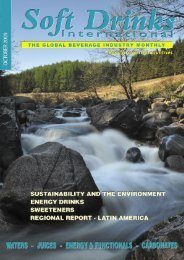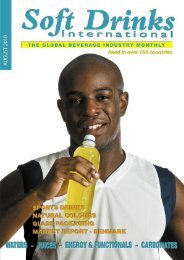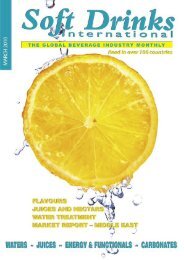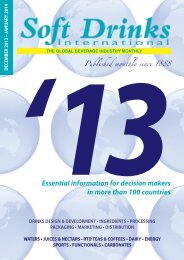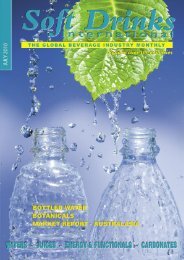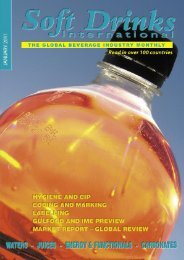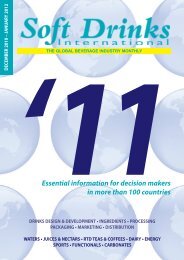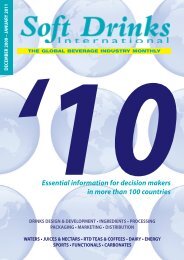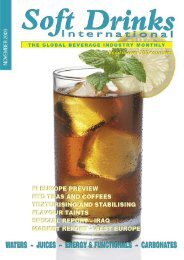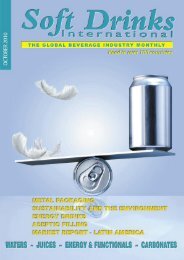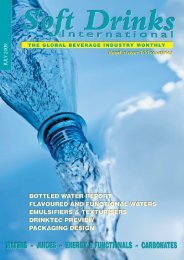Palatinose - Soft Drinks International
Palatinose - Soft Drinks International
Palatinose - Soft Drinks International
Create successful ePaper yourself
Turn your PDF publications into a flip-book with our unique Google optimized e-Paper software.
<strong>Soft</strong> <strong>Drinks</strong> <strong>International</strong> – February 2011<br />
The launch of GWBT is announced. From left to right: Gary Robson, Paul Wilson, Abdul Salam Al Madani, H.E. Helal<br />
Saeed Almarri, Larry Hobbs and Dr Ahmed Al Banna.<br />
“Index Conferences and Exhibitions – a member<br />
of Index Holding – has played a big role since<br />
1990 to raise the national economy of the UAE,<br />
by organising more than 22 international exhibitions<br />
and conferences, which cover all sectors<br />
from medical to education, commercials, technologies,<br />
and entertainments. With more than 20<br />
years of experience as a total management company<br />
it is well positioned to add value to this<br />
strategic partnership.” ■<br />
DDTE<br />
Market background<br />
Total consumption of non-alcoholic beverages in the UAE, including packaged water, reached almost 2.6 billion litres in 2008, worth more<br />
than US$ 1.1 billion at retail level. This corresponds to average per capita consumption of just less than 500 litres per annum, well in<br />
excess of consumption of tea, coffee, and dairy beverages which account for perhaps a further 130 litres per capita. If dispenser water is<br />
excluded, consumption is estimated at 1.5 billion litres, and worth around US$ 1.0 billion. Just three main product groups – carbonates,<br />
juices and water – account for 92% of this market volume.<br />
Recent growth has been driven primarily by a rapidly expanding population in addition to a strong increase in tourist and business visitors.<br />
Market dynamics vary from sector to sector, with some of the key recent developments including:<br />
In Kuwait, the total consumption of non-alcoholic beverages, including packaged water, reached more than 730 million litres in 2008,<br />
and was worth almost US$ 560 million retail. This corresponds to average per capita consumption of just less than 215 litres per annum,<br />
well in excess of consumption of tea, coffee, and dairy beverages which accounts for perhaps a further 140 litres per capita. If dispenser<br />
water is excluded, consumption is estimated at 668 million litres, and is worth just under US$ 550 million.<br />
Although Egypt has one of the largest populations in the Middle East, the non-alcoholic beverages market is relatively small and undeveloped,<br />
particularly when compared to neighboring GCC markets. If dispenser water is excluded, the soft drinks market was valued at<br />
US$ 1.05 billion in 2008, compared with US$ 3.24 billion in Saudi Arabia, a country with 57 million fewer people!<br />
However, consumption is growing strongly at rates way in excess of most GCC markets and reached almost 2.9 billion litres in 2008,<br />
worth close to US$ 1.1 billion retail, if packaged water is included. Growth has averaged almost 14% per annum over the past five years<br />
helped by a reduction in sales tax in 2006 and a step up in the marketing efforts of leading carbonates and juice suppliers.<br />
KSA can justifiably be regarded as the most sophisticated Middle East market for non alcoholic beverages. Not only are per capita<br />
amongst the highest in the region but significant competition in supply has encouraged companies to foster a climate of innovation in an<br />
effort to achieve some degree of differentiation.<br />
Total consumption of non-alcoholic beverages, including packaged water, exceeded 6.1 billion litres in 2008, worth almost US$ 3.4 billion<br />
at retail level. This corresponds to average per capita consumption of around 216 litres per annum, well in excess of consumption of<br />
tea, coffee, and dairy beverages which accounts for perhaps a further 170 litres per capita. If dispenser water is excluded, consumption is<br />
estimated at 4.1 billion litres, and worth around US$ 3.2 billion. Two categories – carbonates and juice products - account for around 70%<br />
of this by value (slightly less in volume terms).<br />
Consumption of non-alcoholic beverages in Oman is growing steadily, averaging growth of 9-10% per annum over the past five years.<br />
Total consumption, including packaged water, was 556 million litres in 2008, worth around US$ 290 million at retail level. This corresponds<br />
to average per capita consumption of around 215 litres per annum, compared with consumption of tea, coffee, and dairy beverages<br />
which accounts for a further 230 litres per capita.<br />
It is not surprising that consumption of non-alcoholic beverages in Qatar, including packaged water, grew at an average rate of more than<br />
14% per annum since 2004 to reach 424 million litres by 2008, worth more than US$ 165 million at retail level. This corresponds to average<br />
per capita consumption of almost 355 litres per annum, well in excess of consumption of tea, coffee, and dairy beverages which account<br />
for perhaps a further 150 litres per capita. If dispenser water is excluded, consumption is estimated at 220 million litres, worth around US$<br />
145 million. Just three main product groups – carbonates, juices and water – account for more than 90% of this market volume<br />
Source: DDTE<br />
51<br />
The first GWBT<br />
will be held in<br />
conjunction with<br />
the fourth<br />
edition of the<br />
Dubai Drink<br />
Technology<br />
Expo, which<br />
will take<br />
place from<br />
29th november<br />
to 1st December<br />
2011.



